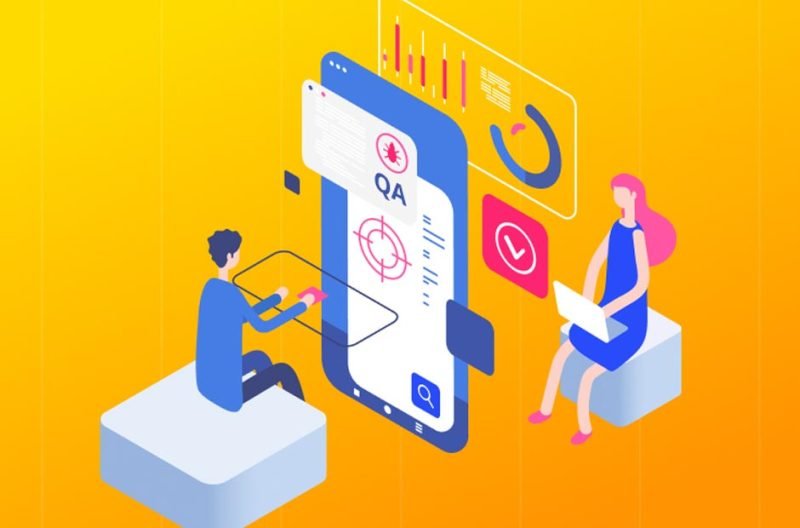
In today’s digital environment, where visuals play a crucial role in user experience, maintaining consistency and ensuring the visual correctness of web applications has become more critical than ever. A single misplaced element, a broken image, or a minor color deviation can adversely impact your product’s user experience and, consequently, your brand’s reputation. This is where Examlabs naturally comes into the picture. Visual regression testing tools are essential for addressing these issues.
Visual regression testing is a crucial component of any software development process. It involves comparing the visual aspects of a web application in its current state to an earlier (baseline) version, looking for any undesired changes or inconsistencies. It can uncover issues that go unnoticed with traditional functional testing methods, enabling developers to rectify them before they reach the end users.
Selecting the right tool for visual regression testing is a pivotal decision that can influence the effectiveness and efficiency of your testing efforts. This article aims to simplify that decision. We will discuss the top 8 automated visual regression testing tools available in 2023, both free and paid, diving into their unique features and strengths.
From open-source solutions suitable for small-scale projects to enterprise-grade tools that can handle complex applications with numerous visual components, we have it all covered. Whether you’re a solo developer, a small startup, or a large corporation, the tools listed here will provide an overview to make an informed decision about the best visual regression testing tool for your specific needs.
1. LambdaTest
LambdaTest is an intelligent unified digital experience testing cloud that helps businesses drastically reduce time to market through faster test execution, ensuring quality releases and accelerated digital transformation. The platform allows you to perform real-time and automation testing across 3000+ environments and real mobile devices, making it a top choice among other cloud testing platforms. Over 10,000+ enterprise customers and 2+ million users across 130+ countries rely on LambdaTest for their testing needs.
It provides a scalable infrastructure for performing various types of testing, including one-of-a-kind AI-powered Visual UI Testing. It enables users to perform real-time testing of web applications across a wide range of browsers, operating systems, and devices. With LambdaTest, developers, and testers can identify visual discrepancies and ensure optimal user experiences across different platforms.
Key Features for Visual Regression Testing:
- Cross-browser compatibility testing: LambdaTest offers seamless cross-browser testing capabilities, allowing users to test their web applications on over 3,000+ browser configurations. It supports popular browsers such as Chrome, Firefox, Yandex, Edge, Brave, Safari, Edge, and Internet Explorer, ensuring comprehensive coverage.
- Automated screenshot comparisons: LambdaTest enables users to capture screenshots of their web applications across multiple browsers and compare them for visual differences. This automated screenshot comparison eliminates the need for manual pixel-by-pixel comparisons, saving time and effort.
- Visual regression testing: LambdaTest’s visual regression testing feature allows users to detect visual inconsistencies between different versions of their web applications. By comparing screenshots taken during different testing cycles, developers can identify any unintended visual changes or regressions.
- Issue tracking and collaboration: LambdaTest integrates with popular bug-tracking systems, allowing users to log and track visual UI issues seamlessly. It also provides collaboration features, enabling teams to work efficiently by sharing screenshots, comments, and annotations.
Benefits:
- Comprehensive cross-browser compatibility: LambdaTest’s extensive browser coverage ensures that web applications are tested on a wide range of browsers, helping developers proactively identify and address compatibility issues.
- Time and cost savings: LambdaTest’s cloud-based infrastructure eliminates the need for maintaining an extensive device lab, reducing infrastructure costs. Moreover, its automated screenshot comparisons, and regression testing capabilities save valuable time for developers and testers.
- Improved collaboration and issue resolution: LambdaTest’s collaboration features foster effective communication and collaboration among team members. With the ability to share screenshots and add comments, teams can quickly identify and resolve visual UI issues.
- Enhanced user experience: LambdaTest helps deliver a seamless user experience across different platforms by ensuring cross-browser compatibility and visual consistency. This leads to increased user satisfaction and improved brand reputation.
2. BackstopJS
BackstopJS is an open-source tool that captures screenshots and performs visual comparisons against a reference image. It provides developers with flexible configuration options, making it adaptable to different testing scenarios. BackstopJS integrates seamlessly into existing workflows and supports headless browsers, making it a versatile choice for automated visual regression testing.
Key Features:
- Easy setup and configuration: BackstopJS provides a simple command-line interface and a configuration file that allows developers to define test scenarios, including URLs, viewport sizes, and interaction steps.
- Intelligent regression testing: By capturing screenshots and comparing them against a reference image, BackstopJS identifies visual differences down to the pixel level. It highlights any deviations and generates comprehensive reports for easy analysis.
- Interactive mode: BackstopJS offers an interactive mode allowing developers to manually review and approve visual differences. This feature is handy when dealing with dynamic or unpredictable content.
3. Resemble.js
Resemble.js is a lightweight image analysis library that enables pixel-by-pixel comparison of images. It provides developers with a simple API for creating custom visual regression tests effortlessly. Resemble.js can be used in combination with other testing frameworks or as a standalone tool.
Key Features:
- Image analysis: js analyzes images and generates a visual diff that highlights discrepancies between them. It compares pixel values and provides detailed information about color differences, brightness, and opacity variances.
- Customizable threshold settings: Developers can define threshold values to control the sensitivity of the comparison process. This allows them to adjust the level of strictness in identifying visual differences based on their specific needs.
- Extensibility:js can be easily integrated into existing test frameworks such as Jasmine or Mocha, enabling seamless integration with other testing processes.
4. Wraith
Wraith, built on top of PhantomJS, is a visual regression testing tool that captures screenshots and performs image comparisons. It offers support for multiple screen sizes and conveniently generates HTML reports, making it easier to analyze and track visual differences over time.
Key Features:
- Cross-browser testing: Wraith supports testing across different browsers and versions, ensuring consistency across various environments. This feature is precious when targeting a wide range of users with diverse browser preferences.
- Multiple screen sizes: With Wraith, developers can capture screenshots at different viewport sizes, allowing them to test the responsiveness of their applications. This ensures that visual elements adapt correctly across various screen resolutions.
- History tracking: Wraith keeps a history of the captured screenshots, allowing developers to compare them over time. This feature facilitates the detection of subtle visual changes that may occur due to code updates or third-party integrations.
5. Gemini
Gemini is a powerful and free visual regression testing tool developed by Yandex. It offers developers a seamless and efficient way to detect visual changes in web applications. With its intuitive workflow and robust features, Gemini has become a popular choice among developers in 2023.
Key Features:
- Image-based comparison: Gemini captures screenshots of web pages during the testing process and performs image-based comparisons to identify visual differences. It uses pixel-to-pixel comparison to detect even the smallest variations in layout, styling, or content.
- Smart diffing: Gemini employs smart diffing algorithms that highlight the areas of the web page that have changed. This helps developers quickly identify the specific elements or regions that need attention, making debugging and issue resolution faster and more efficient.
- Support for multiple browsers: Gemini supports testing across different browsers, enabling developers to ensure visual consistency and compatibility across various environments. It allows them to specify browser versions and configurations, providing accurate results.
- Advanced configuration options: Gemini provides developers with extensive configuration options, allowing them to customize the testing process according to their specific needs. It supports fine-grained control over viewport sizes, screen resolutions, and other parameters, enabling comprehensive visual testing.
- Integration with testing frameworks: Gemini seamlessly integrates with popular testing frameworks like Mocha and Jasmine, making it easy to incorporate visual regression tests into existing test suites. This integration streamlines the testing process and enables developers to leverage the power of Gemini without disrupting their established workflows.
- Robust reporting: Gemini generates detailed and visually appealing reports highlighting visual differences and providing insights into the testing results. The reports include side-by-side comparisons, highlighting the reference and the captured images, making it easy to understand the specific visual changes that have occurred.
- Scalability: Gemini is designed to handle large-scale web applications with ease. It offers parallel testing capabilities, allowing developers to execute tests concurrently and significantly reducing the overall testing time.
6. Applitools
Applitools has established itself as a market leader in visual regression testing with its powerful platform. It offers a comprehensive tool suite that enables efficient testing across multiple browsers, operating systems, and devices. Applitools utilizes AI-powered visual testing to identify even the slightest visual discrepancies in web applications.
Key Features:
- Ultrafast testing: Applitools leverages AI to analyze and compare visual elements, reducing testing time significantly.
- Cross-browser and device testing: It provides extensive cross-browser and device compatibility, ensuring consistent visual experiences across platforms.
- Integrations and collaboration: Applitools integrates seamlessly with popular testing frameworks, bug-tracking systems, and collaboration tools, making it easy to incorporate into existing workflows.
Benefits:
- Accelerated release cycles: By automating visual testing, Applitools saves valuable development time, allowing faster software releases.
- Improved visual quality: With its advanced AI algorithms, Applitools catches visual regressions that might go unnoticed through manual testing.
- Enhanced team collaboration: Its collaboration features facilitate effective communication between developers, testers, and other stakeholders, leading to better collaboration and issue resolution.
7. Ghost Inspector
Ghost Inspector is a comprehensive automated testing tool that includes visual regression testing capabilities. It allows developers to create and execute tests across browsers and devices, capturing screenshots to detect visual changes. Ghost Inspector’s intuitive interface and powerful features make it a popular choice among development teams.
Key Features:
- Test creation and execution: Ghost Inspector provides a user-friendly interface for creating and running automated tests, including visual regression tests.
- Screenshot comparisons: It captures screenshots during test execution and performs visual comparisons to identify any visual inconsistencies.
- Integrations and reporting: Ghost Inspector integrates with various popular tools, such as CI/CD systems and bug-tracking platforms, and provides detailed reports for analysis.
Benefits:
- Easy test creation: Ghost Inspector simplifies the process of creating automated tests, allowing developers to set up visual regression tests quickly.
- Comprehensive test coverage: With support for multiple browsers and devices, Ghost Inspector ensures thorough testing across various configurations.
- Actionable reports: Their detailed reports provide valuable insights into visual regressions, helping teams prioritize and address issues effectively.
8. CrossBrowserTesting
Cross BrowserTesting, as the name suggests, primarily focuses on cross-browser testing. It offers a comprehensive suite of tools to automate visual regression testing across a wide range of browsers, devices, and operating systems. With its cloud-based infrastructure, Cross BrowserTesting simplifies the process of running tests on multiple configurations.
Key Features:
- Cross-browser compatibility: Cross BrowserTesting allows developers to test web applications on numerous browsers, ensuring consistent visual rendering.
- Real-time testing: It offers live testing capabilities, enabling developers to interact with applications across various browsers and devices in real time.
- Test automation: Cross BrowserTesting supports automated visual regression testing, allowing developers to run tests in parallel and across multiple configurations.
Benefits:
- Streamlined cross-browser testing: By automating visual regression testing across multiple browsers, Cross BrowserTesting helps ensure a consistent user experience.
- Enhanced testing efficiency: Its live testing capabilities enable developers to identify visual issues in real time, expediting the debugging process.
- Cloud-based infrastructure: With its cloud-based approach, Cross BrowserTesting eliminates the need for maintaining an extensive device and browser lab, saving resources and simplifying the testing process.
Conclusion
In 2023, a range of automated visual regression testing tools, both free and paid, will provide valuable solutions for developers and QA professionals. The top eight tools explored in this article offer seamless integration, powerful features, and scalability options.
Free tools like LambdaTest, BackstopJS, and ResembleJS provide flexibility and control without any cost. They enable developers to incorporate visual regression testing into their workflows effortlessly. Paid tools such as Applitools, Screener, LambdaTest, and Applitools’ Ultrafast Grid offer advanced features and comprehensive solutions. These tools cater to different needs, including AI-powered testing, collaboration, scalability, and multi-platform testing.
With the help of these automated visual regression testing tools, teams can streamline their testing processes, detect visual discrepancies efficiently, and ensure visually flawless user experiences. Whether it’s small teams or large organizations, there is a tool available to meet their specific requirements.
In conclusion, these tools empower developers and QA professionals to deliver high-quality, visually consistent web applications. By incorporating these tools into their testing workflows, teams can enhance user satisfaction and build trust in their products.

